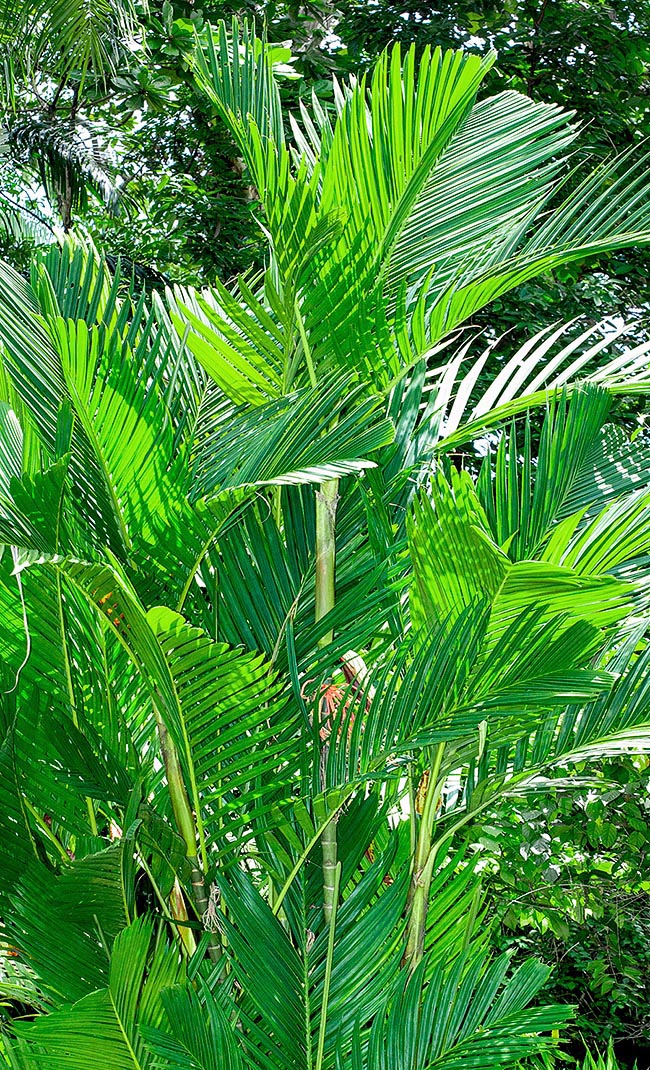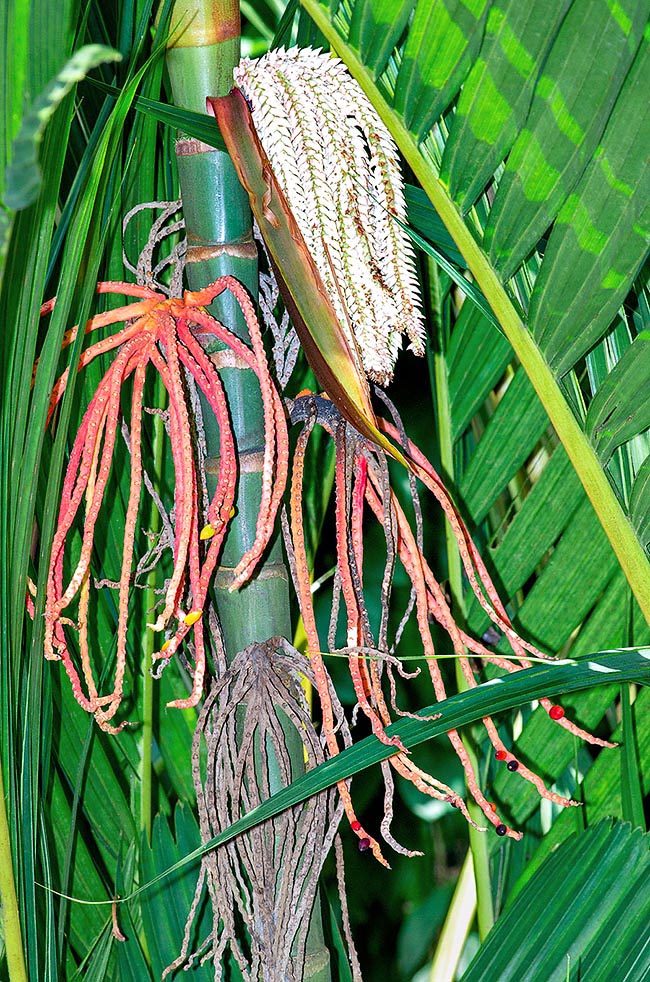Family : Arecaceae

Text © Alessandro Marini

English translation by Mario Beltramini

Piranga crassipes is a cespitose monoecious species, even 2 m tall, very frequent in the Bornean pluvial forests © Giuseppe Mazza
Pinanga crassipes Becc. is a medium-sized monoecious species native to the underwood of Borneo rainforests, where it is very diffused.
The name of the genus Pinanga comes from the Latinization of the Malay epithet “panang” given to this group of palms, having more than 170 recognized species.
The name of the species “crassipes” comes from the Latin terms “crassus” meaning big and “pes”, meaning foot, in this case stem, and refers to the relatively big size of the stem in respect to the other species of this genus, like, for instance, Pinanga coronata.
Pinanga crassipes is a species of limited size, usually multi stemmed, rarely solitary, that presents a robust stem, up to 7 cm broad that may reach the height of 2 m.
It is a variably coloured stem, depending on the age and the cultivation conditions of the palm, from dark green in the young specimens, to pale yellow in the intermediate ones and, finally, grey in the aged ones.
On the stem are quite evident the brown rings corresponding to the nasal scars of the fallen leaves.
Often at the base of the stem get out massive aerial roots that have the purpose of stabilizing the plant.
The pinnate and coriaceous leaves can reach 1 m of height. They are of pale green colour when adult, with the rachis of colour varying from green to bright yellow.
The new emerging leaf has a colour that can vary from red to pink.
The thin foliar segments are run by evident veins.
In the young specimens the leaves are undivided, bifid, of colour varying from pale green to dark green, characterized by irregular spots of contrasting colour, that may change from dark green to brown.
While growing, the leaves of the Pinanga crassipes start dividing, a little at a time, in several irregular segments, with notched tips, but maintain the contrasting maculation till when the plant is mature.
The petioles, up to 30 cm long, are smooth, of colour varying from green to yellow, and continue on the stem with a sheath wrapping it completely, up to 30 cm long, of the same colour as the petiole.

Inflorescence and various rachises, with the last fruits at different stages of ripening © Giuseppe Mazza
The inflorescences emerge under the foliar sheaths. They are very ramified, with the rachis of colour varying from red to yellow, and bear the characteristic triads of flowers formed by 2 male flowers and one female, of ivory colour.
They are plants producing several inflorescences and many fruits. Initially, these are yellow, then turn red and finally black when ripe.
About 1 cm long, they have an oval form, slightly pointed at the apex and contain only one seed.
Pinanga crassipes is one of the most interesting species among those of the genus Pinanga, due to the contrasting colours of the leaves, the petioles, the sheaths and of the inflorescences, and is very much sought after by the botanic gardens and the collectors.
It is clearly a tropical species needing temperatures over 20 °C in order to grow up luxuriant.
Being native to the underwood of the pluvial forests, it needs, of course, a lot of atmospheric humidity and is designed for standing the winds, especially the dry ones that easily lead the plants to dehydration and death.
Pinanga crassipes prefers a position in the shade and does not like the direct rays of the sun that burn its leaves.
The cultivation ground must be rich in humus and preferably slightly acidic, maintained always humid because it is a plant that does not stand drought.
Conversely, the substratum must be porous and very well drained, and for this purpose we can add sand and agri-perlite in order to get it sufficiently porous.
It can be reproduced by division of the tufts, but more easily, by seed that germinates in 1-3 months when in a warm environment.
There are not known synonyms for this species.
